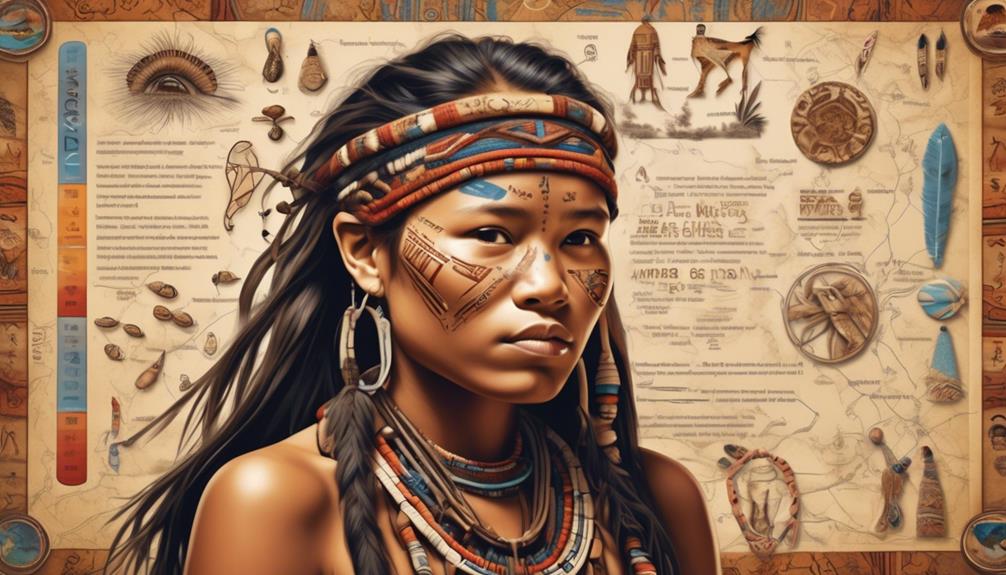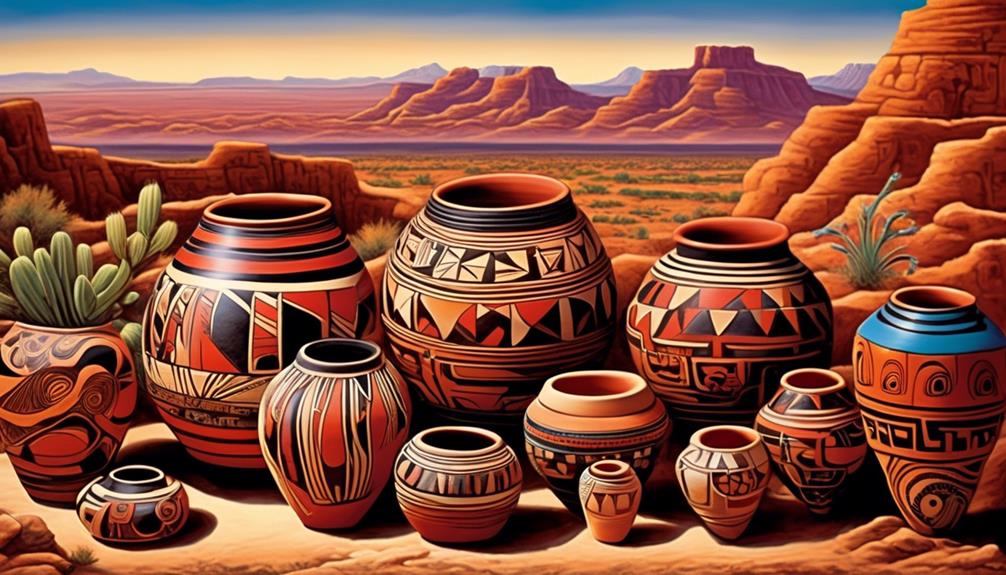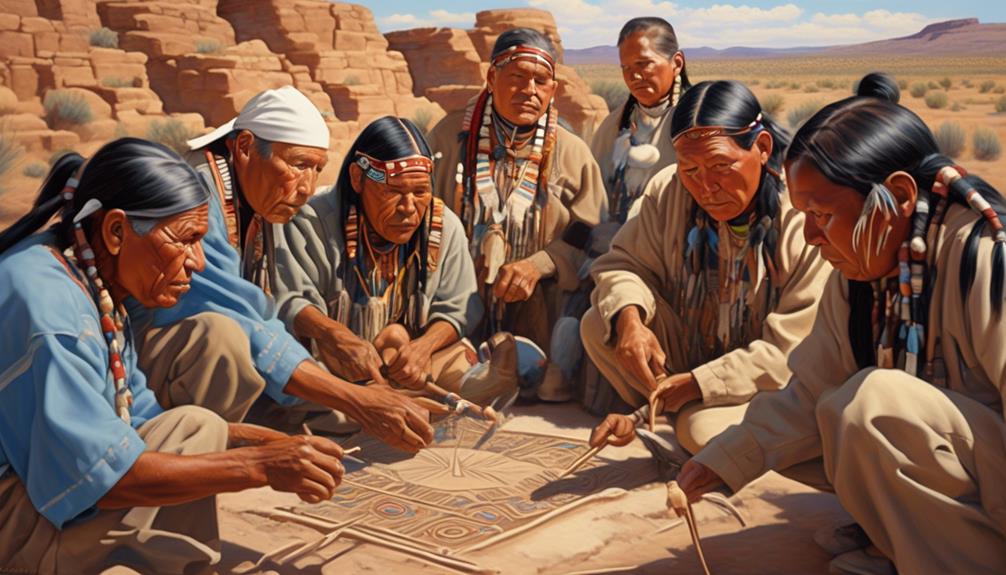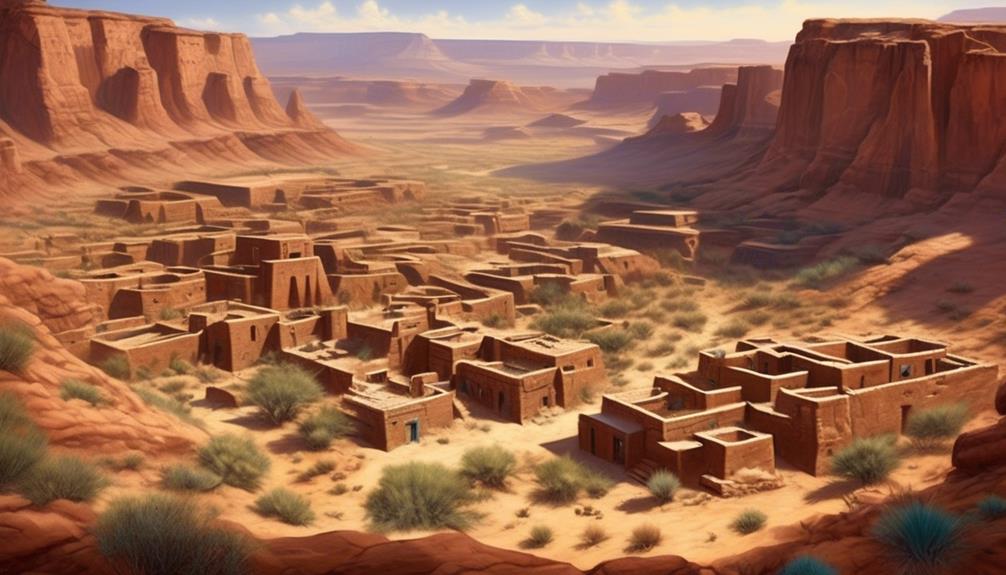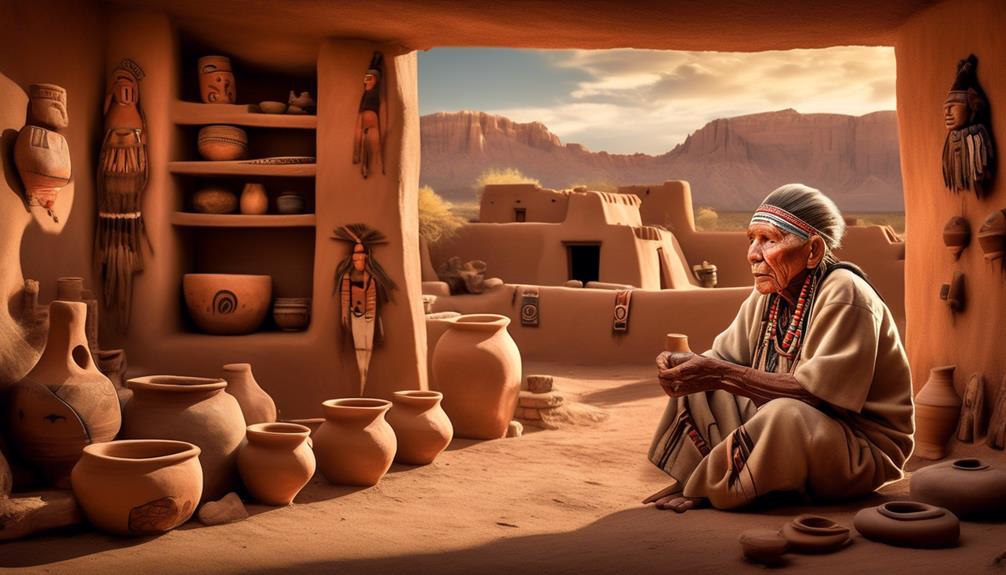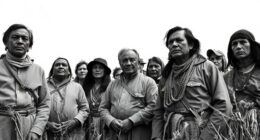When considering the physical features of the Hopi Tribe, it is impossible not to be intrigued by the unique landscape that has shaped their culture for many years. From the striking mesas and buttes that dominate the skyline to the intricate pueblo villages tucked away in the arid terrain, the ancestral land of the Hopi Tribe displays both strength and magnificence.
But there's more to these physical features than meets the eye, and understanding their significance offers a glimpse into the deep connection between the Hopi people and their land.
Key Takeaways
- Mesas and buttes are distinctive natural landmarks in the Hopi Tribe's traditional lands, providing advantageous locations for farming and serving as foundations for dwellings.
- Pueblo villages, such as Oraibi and Walpi, are enduring testaments to the Hopi Tribe's cultural heritage, featuring multi-storied adobe dwellings blending with the natural landscape.
- The Hopi Tribe has adapted to the arid landscape through traditional agriculture, utilizing terraced fields, innovative irrigation methods, and dry farming techniques.
- Rugged rock formations, shaped by erosion patterns, hold cultural and spiritual significance for the Hopi Tribe, serving as focal points for reflection and associated with different deities.
Mesas and Buttes
Mesas and buttes are prominent geographical features in the traditional lands of the Hopi Tribe, serving as distinctive natural landmarks and contributing to the unique landscape of their territory.
The mesas, with their flat-topped tops and steep sides, have played a crucial role in the agricultural practices of the Hopi people. These elevated plateaus provide an advantageous location for farming, offering a level surface that helps in retaining water for the crops. The Hopi have ingeniously constructed a system of terraces on the mesas, enabling them to cultivate corn, beans, and squash in this arid environment.
Buttes, on the other hand, have been historically utilized as natural shelters and foundations for the Hopi people's dwellings. These towering rock formations provided protection and served as the base for the construction of homes, some of which can still be seen today at sites like Old Oraibi, one of the oldest continuously inhabited villages in the United States.
The integration of these physical features into the daily lives of the Hopi Tribe showcases their deep understanding of the land and their ability to adapt to and thrive in this challenging environment.
Pueblo Villages
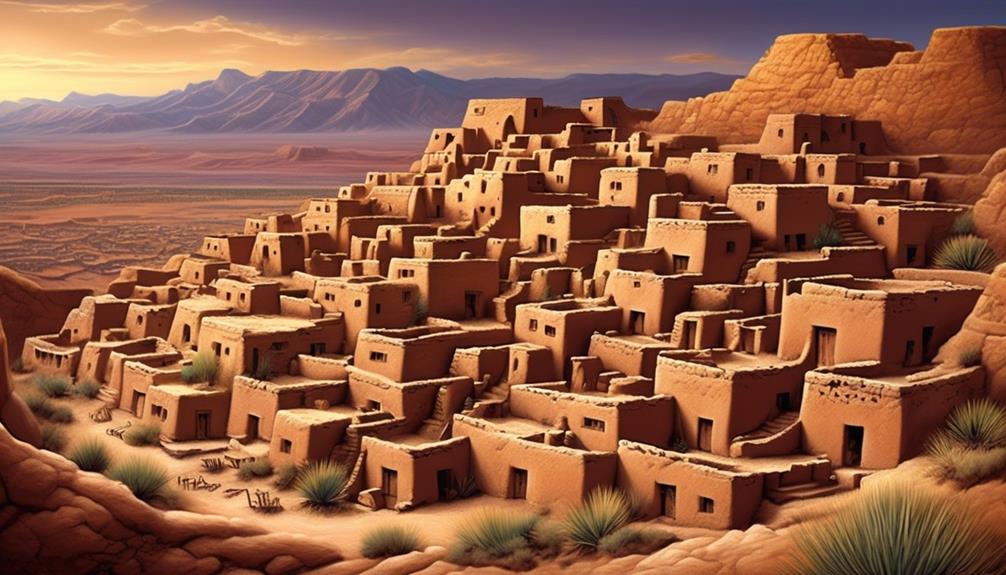
Nestled among the mesas and buttes, the Pueblo villages of the Hopi Tribe stand as enduring testaments to their rich cultural heritage and traditional way of life. The pueblo architecture is striking, with multi-storied adobe dwellings that seem to emerge from the earth itself. The villages, such as Oraibi and Walpi, have been continuously inhabited for centuries and are a marvel of ancient engineering and community living. The buildings are constructed from locally sourced materials, blending seamlessly with the natural landscape. The villages are organized around central plazas, where communal activities and ceremonies take place.
| Emotions | Description |
|---|---|
| Awe | The imposing adobe structures evoke a sense of wonder and respect for the Hopi people's ingenuity. |
| Reverence | The interconnectedness of the pueblo villages with nature inspires a deep sense of respect for the environment. |
| Contemplation | The peaceful and serene atmosphere of the villages encourages reflection on the timeless traditions and practices of the Hopi Tribe. |
| Intrigue | The unique architectural style and layout of the villages pique curiosity about the daily lives and rituals of the Hopi people. |
The agricultural practices of the Hopi Tribe are interwoven with the pueblo villages, as farming is central to their way of life. The villages are surrounded by terraced fields, where the Hopi grow corn, beans, and squash using ancient irrigation techniques. This sustainable approach to agriculture reflects the deep connection between the Hopi people and the land they inhabit.
Arid Landscape
The pueblo villages of the Hopi Tribe, with their enduring architectural marvel, are set against an arid landscape characterized by sparse vegetation and rugged terrain. The Hopi people have adapted to this challenging environment through traditional agriculture and farming techniques, utilizing terraced fields and innovative irrigation methods to cultivate crops such as corn, beans, and squash. The use of dry farming techniques, including the construction of water catchment basins known as 'puquios,' has allowed the Hopi to sustain their agricultural practices in this arid region.
In addition to their advanced agricultural methods, the Hopi have also utilized adobe architecture and construction methods to create their distinctive pueblo villages. The use of adobe bricks, made from a mixture of mud, clay, and straw, has enabled the construction of multi-story buildings that provide insulation from the extreme temperature variations of the desert environment. The compact, terraced layout of the villages reflects the Hopi's deep connection to the land and their efforts to optimize space in a challenging landscape.
These traditional farming and architectural practices demonstrate the resilience and ingenuity of the Hopi people in adapting to their arid surroundings.
Rock Formations

Carved by millennia of geological processes, the rugged rock formations in the Hopi Tribe's landscape stand as enduring testaments to the forces of nature. Erosion patterns have sculpted these formations into mesmerizing shapes, showcasing the geological significance of the region. The stratification of the rocks reveals the passage of time, with each layer bearing witness to ancient environmental changes.
These formations not only serve as a testament to the Earth's history but also hold deep cultural and spiritual significance for the Hopi Tribe. Many of the rocks are integral to traditional ceremonies and hold spiritual connections to the tribe's beliefs and practices. The Hopi people have long revered these formations, incorporating them into their oral traditions and rituals. The unique shapes and textures of the rocks are often associated with different deities and have become focal points for spiritual reflection and meditation.
As such, the rock formations in the Hopi landscape encapsulate both the geological story of the land and the spiritual essence of the tribe, making them an integral part of the tribe's cultural heritage.
Sacred Springs
Sacred Springs, like the rock formations, hold profound cultural and spiritual significance for the Hopi Tribe, representing vital elements of their traditional ceremonies and spiritual beliefs. These natural water sources are integral to the tribe's traditional ceremonies, symbolizing the life-giving properties of water and its role in sustaining the community. The spiritual significance of the springs is evident in the rituals and prayers conducted by the Hopi people, emphasizing the importance of water conservation and preservation.
The sacred springs serve as focal points for community rituals, where the Hopi Tribe comes together to honor their ancient traditions and connect with the spiritual realm. The purity of the water from these springs is believed to enhance the effectiveness of their ceremonies, fostering a deep spiritual connection with their ancestors and the natural world.
In addition to their ceremonial importance, the sacred springs also play a crucial role in promoting water conservation within the tribe. The Hopi people view these natural water sources as precious gifts from the earth, instilling a sense of responsibility to protect and cherish them for future generations. As a result, the tribe actively engages in practices that ensure the sustainability of these sacred springs, reflecting their deep respect for the environment and the spiritual significance of water in their culture.
Frequently Asked Questions
What Are the Traditional Agricultural Practices of the Hopi Tribe and How Do They Adapt to the Arid Landscape?
Traditional farming techniques of the Hopi tribe are rooted in their deep understanding of the arid landscape. They skillfully utilize terraced fields and irrigation systems to conserve water and cultivate crops.
Their agricultural practices, such as dry farming and planting drought-resistant crops, showcase their adaptation to the challenging environment. The Hopi people's respect for the land and their innovative methods highlight their ability to thrive in arid conditions.
What Role Do Katsinam (Spirit Messengers) Play in Hopi Religious Ceremonies and Cultural Traditions?
In Hopi ceremonies, the katsinam, or spirit messengers, play a vital role. Their spiritual significance is deeply rooted in Hopi traditions, representing the connection between the physical and spiritual worlds.
These ceremonies are rich in symbolism and tradition, with the katsinam guiding and teaching the Hopi people. Their presence is integral to maintaining the cultural identity and spiritual practices of the Hopi tribe.
How Do the Hopi People Maintain Their Cultural Identity and Traditions in the Modern World?
Maintaining our cultural identity and traditions in the modern world is a constant challenge. We strive to preserve our heritage through ceremonies, language, and storytelling.
However, modern influences and globalization pose significant hurdles. To combat this, we actively engage in cultural preservation efforts, such as educational programs and community events.
What Are Some Common Misconceptions About the Hopi Tribe and Their Physical Features?
Common misconceptions about the physical appearance of the Hopi tribe often stem from stereotypical portrayals. It's important to understand that physical features among the Hopi people vary widely, just like in any community.
Misunderstood features shouldn't overshadow the rich cultural heritage and traditions of the Hopi tribe. By acknowledging and respecting this diversity, we can appreciate the true essence of the Hopi people beyond surface-level physical traits.
How Has the Hopi Tribe's Relationship With the Land and Natural Resources Evolved Over Time?
Our understanding of the Hopi tribe's relationship with the land and natural resources has evolved over time.
The evolution of land use and natural resource management reflects the Hopi's deep connection to their environment.
Through sustainable practices and traditional knowledge, the tribe has adapted to changing environmental conditions while preserving their cultural heritage.
This harmonious relationship with the land has been pivotal in shaping the Hopi way of life for generations.
Conclusion
In conclusion, the physical features of the Hopi tribe's homeland are like a living museum, with towering mesas and buttes standing sentinel over the arid landscape.
The pueblo villages are like ancient fortresses, nestled among the rock formations, and the sacred springs are like precious jewels hidden within the earth.
The beauty and power of these natural elements have shaped the Hopi people and their culture for generations, creating a landscape that's both awe-inspiring and deeply spiritual.

